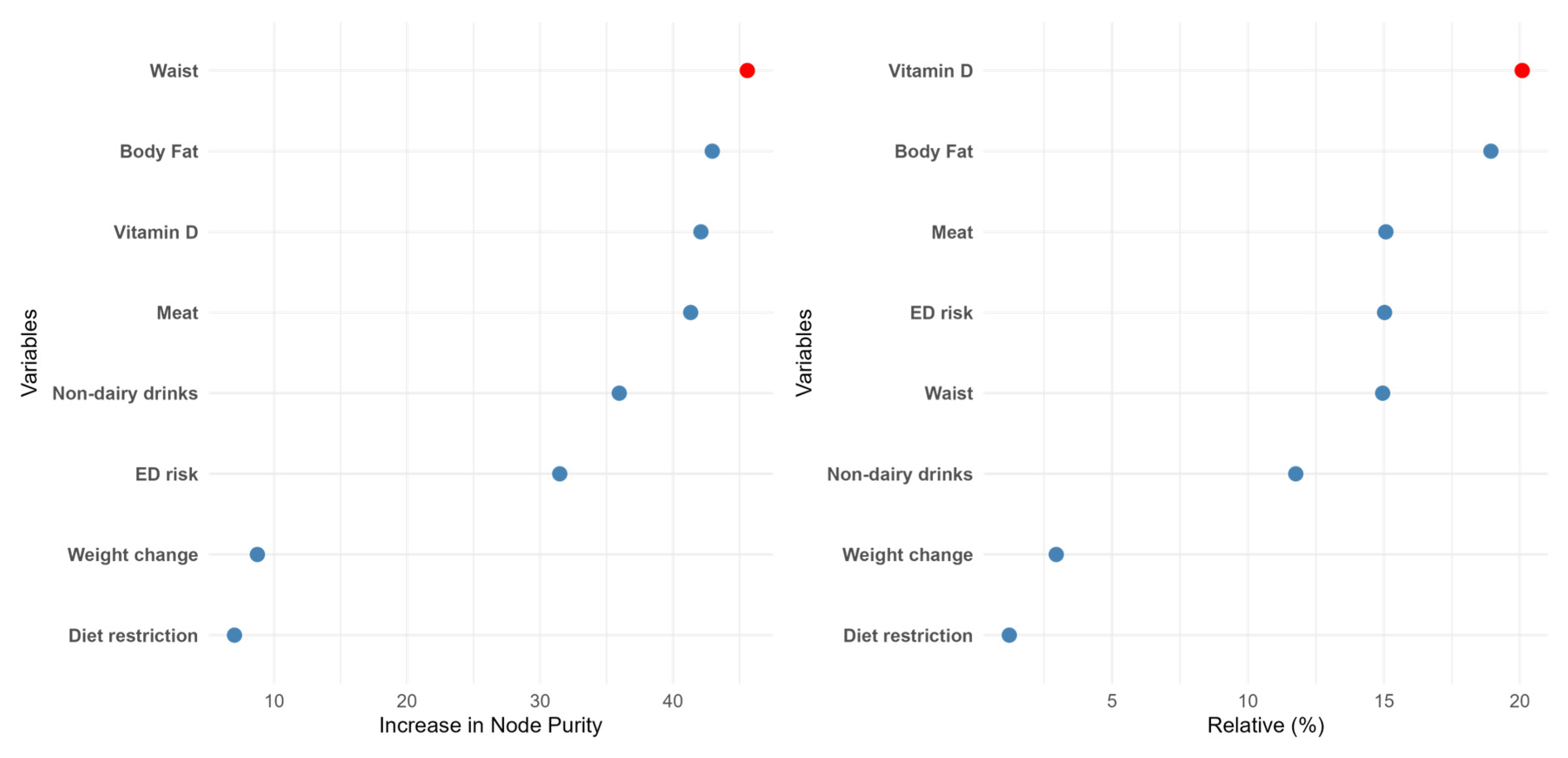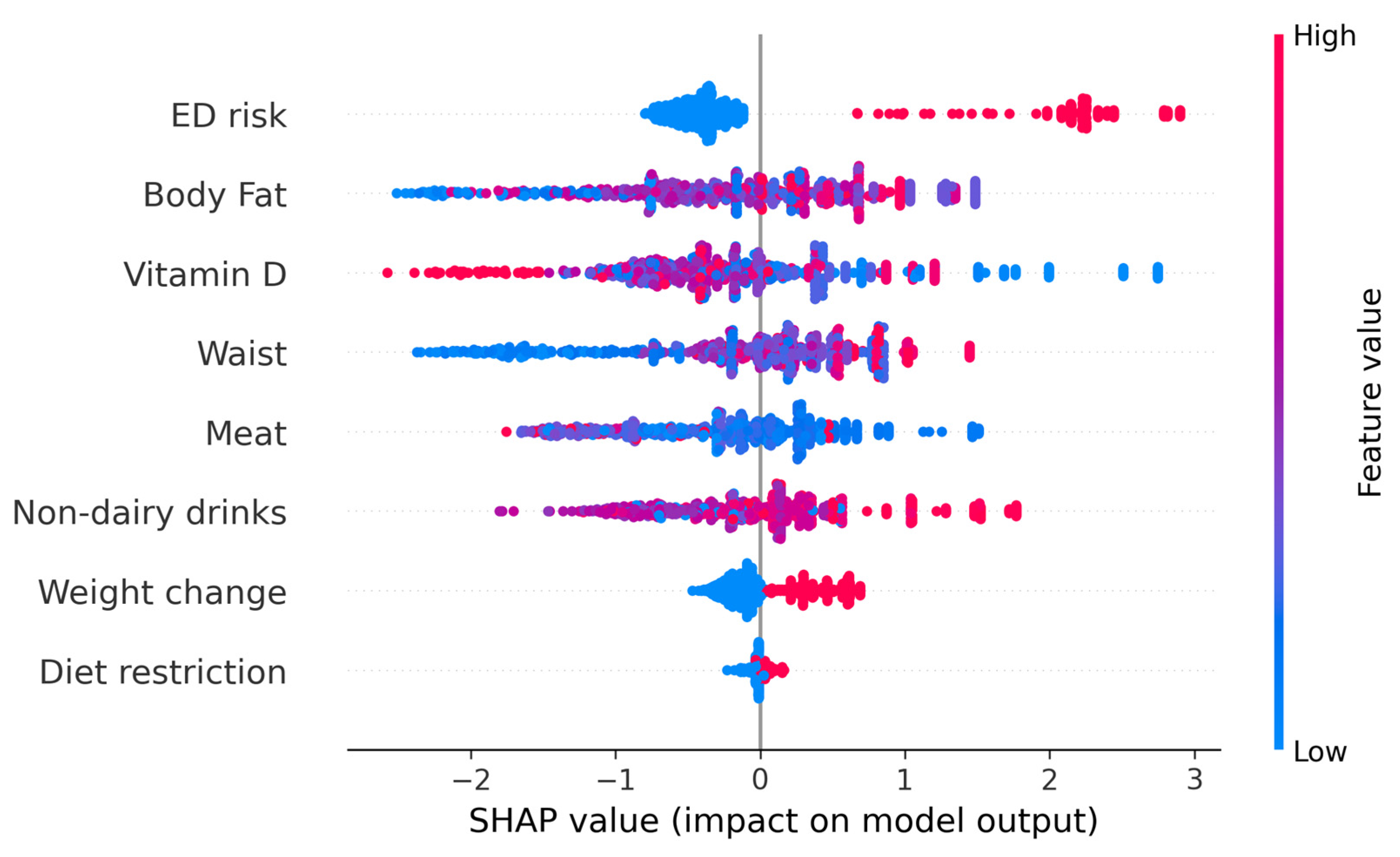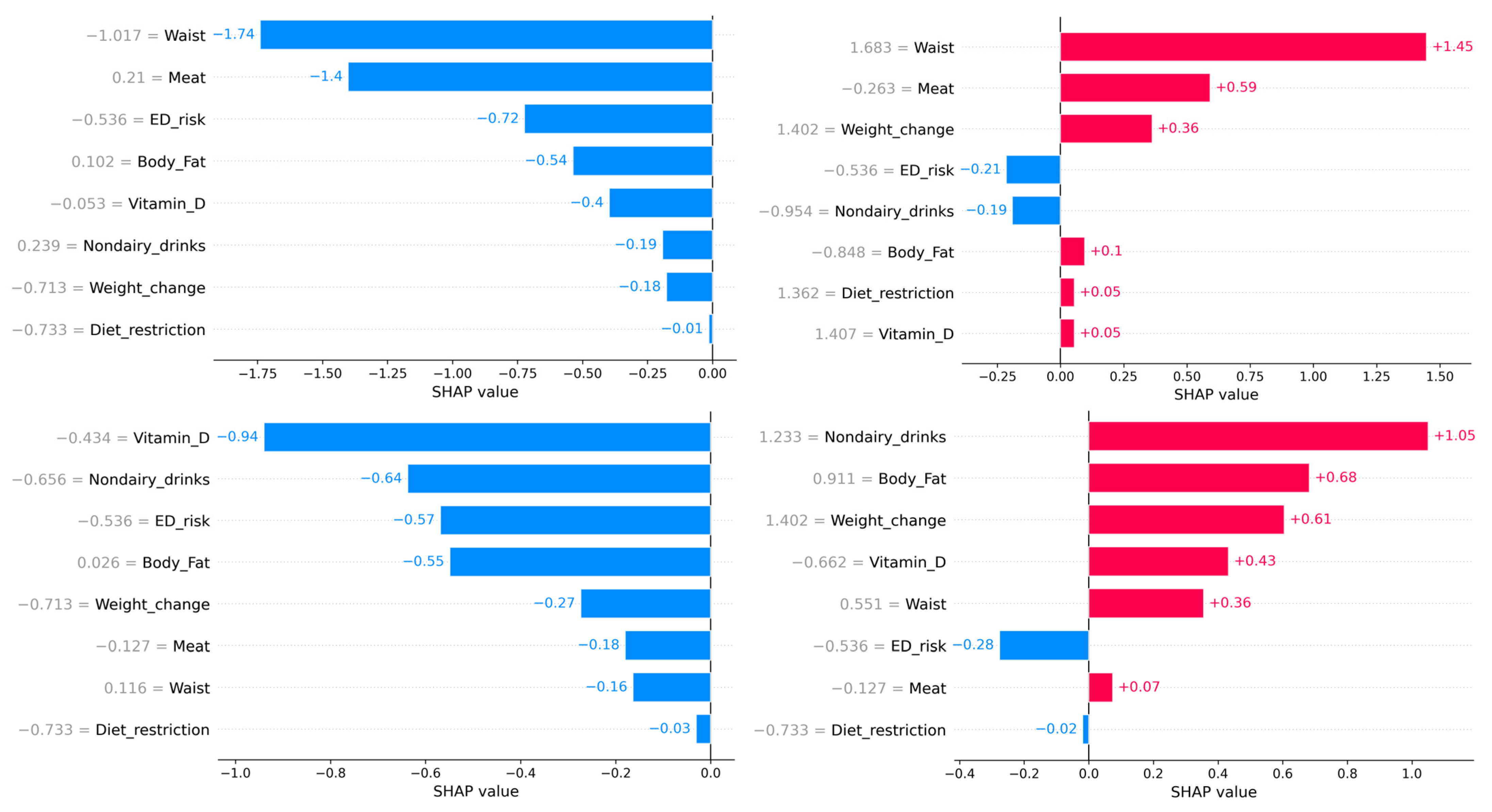Anthropometric, Nutritional, and Lifestyle Factors Involved in Predicting Food Addiction: An Agnostic Machine Learning Approach
Abstract
1. Introduction
2. Materials and Methods
2.1. Design and Participants
2.2. Measures
2.2.1. Demographics and Lifestyle Data
2.2.2. Food Frequency
2.2.3. Eating Disorders Screening
2.2.4. Food Addiction
2.2.5. Anthropometric Variables
2.3. Statistical Analysis
3. Results
3.1. Baseline Characteristics of Participants
3.2. Nutrient and Food Intake
3.3. Screening for Eating Disorders and Food Addiction
3.4. Models for the Prediction of Food Addiction
4. Discussion
5. Conclusions
Supplementary Materials
Author Contributions
Funding
Institutional Review Board Statement
Informed Consent Statement
Data Availability Statement
Acknowledgments
Conflicts of Interest
Abbreviations
| BMI | Body Mass Index |
| EAT-26 | Eating Attitudes Test-26 |
| ED | Eating Disorder |
| FA | Food Addiction |
| FFQ | Food Frequency Questionnaire |
| SHAP | Shapley Additive Explanations |
| YFAS 2.0 | Yale Food Addiction Scale 2.0 |
References
- Van Hoeken, D.; Hoek, H.W. Review of the Burden of Eating Disorders: Mortality, Disability, Costs, Quality of Life, and Family Burden. Curr. Opin. Psychiatry 2020, 33, 521–527. [Google Scholar] [CrossRef]
- Solmi, M.; Radua, J.; Olivola, M.; Croce, E.; Soardo, L.; Salazar de Pablo, G.; Il Shin, J.; Kirkbride, J.B.; Jones, P.; Kim, J.H.; et al. Age at Onset of Mental Disorders Worldwide: Large-Scale Meta-Analysis of 192 Epidemiological Studies. Mol. Psychiatry 2022, 27, 281–295. [Google Scholar] [CrossRef]
- Becetti, I.; Bwenyi, E.L.; de Araujo, I.E.; Ard, J.; Cryan, J.F.; Farooqi, I.S.; Ferrario, C.R.; Gluck, M.E.; Holsen, L.M.; Kenny, P.J.; et al. The Neurobiology of Eating Behavior in Obesity: Mechanisms and Therapeutic Targets: A Report from the 23rd Annual Harvard Nutrition Obesity Symposium. Am. J. Clin. Nutr. 2023, 118, 314–328. [Google Scholar] [CrossRef] [PubMed]
- Hauck, C.; Cook, B.; Ellrott, T. Food Addiction, Eating Addiction and Eating Disorders. Proc. Nutr. Soc. 2020, 79, 103–112. [Google Scholar] [CrossRef]
- Krupa, H.; Gearhardt, A.N.; Lewandowski, A.; Avena, N.M. Food Addiction. Brain Sci. 2024, 14, 952. [Google Scholar] [CrossRef] [PubMed]
- Florio, L.; Lassi, D.L.S.; De Azevedo-Marques Perico, C.; Vignoli, N.G.; Torales, J.; Ventriglio, A.; Castaldelli-Maia, J.M. Food Addiction: A Comprehensive Review. J. Nerv. Ment. Dis. 2022, 210, 874–879. [Google Scholar] [CrossRef] [PubMed]
- Ferreira-Hermosillo, A.; de Miguel Ibañez, R.; Pérez-Dionisio, E.K.; Villalobos-Mata, K.A. Obesity as a Neuroendocrine Disorder. Arch. Med. Res. 2023, 54, 102896. [Google Scholar] [CrossRef]
- Schankweiler, P.; Raddatz, D.; Ellrott, T.; Cirkel, C.H. Correlates of Food Addiction and Eating Behaviours in Patients with Morbid Obesity. Obes. Facts 2023, 16, 465–474. [Google Scholar] [CrossRef]
- Praxedes, D.R.; Silva-Júnior, A.E.; Macena, M.L.; Gearhardt, A.N.; Bueno, N.B. Prevalence of Food Addiction among Patients Undergoing Metabolic/Bariatric Surgery: A Systematic Review and Meta-Analysis. Obes. Rev. 2023, 24, e13529. [Google Scholar] [CrossRef]
- Pursey, K.M.; Stanwell, P.; Gearhardt, A.N.; Collins, C.E.; Burrows, T.L. The Prevalence of Food Addiction as Assessed by the Yale Food Addiction Scale: A Systematic Review. Nutrients 2014, 6, 4552–4590. [Google Scholar] [CrossRef]
- Burrows, T.; Kay-Lambkin, F.; Pursey, K.; Skinner, J.; Dayas, C. Food Addiction and Associations with Mental Health Symptoms: A Systematic Review with Meta-Analysis. J. Hum. Nutr. Diet. 2018, 31, 544–572. [Google Scholar] [CrossRef] [PubMed]
- Li, Y.; Fan, Y.; Lin, J.; Shi, S. Does How Individuals Handle Social Situations Exacerbate the Relationship between Physique Anxiety and Food Addiction? The Role of Emotional Expressive. PeerJ 2024, 12, e17910. [Google Scholar] [CrossRef] [PubMed]
- Rivera-Mateos, M.; Ramos-Lopez, O. Prevalence of Food Addiction and Its Association with Lifestyle Factors in Undergraduate Students from Northwest Mexico. J. Addict. Dis. 2023, 41, 308–316. [Google Scholar] [CrossRef] [PubMed]
- Romero-Blanco, C.; Hernández-Martínez, A.; Parra-Fernández, M.L.; Onieva-Zafra, M.D.; Prado-Laguna, M.D.C.; Rodríguez-Almagro, J. Food Addiction and Lifestyle Habits among University Students. Nutrients 2021, 13, 1352. [Google Scholar] [CrossRef]
- Escrivá-Martínez, T.; Galiana, L.; Herrero, R.; Rodríguez-Arias, M.; Fernández-Aranda, F.; Gearhardt, A.N.; Baños, R.M. Food Addiction and Its Relationship with Other Eating Behaviours among Spanish University Students. J. Eat. Disord. 2023, 11, 60. [Google Scholar] [CrossRef]
- Reche-García, C.; Piernas, C.; Martínez-Rodríguez, A.; Sánchez-Guerrero, A.; Hernández-Morante, J.J. Dietary Intakes among People with vs without Food Addiction: A Systematic Review and Meta-Analysis. Clin. Nutr. 2022, 41, 1770–1780. [Google Scholar] [CrossRef]
- Ramón-Arbués, E.; Sagarra-Romero, L.; Echániz-Serrano, E.; Granada-López, J.M.; Cobos-Rincón, A.; Juárez-Vela, R.; Navas-Echazarreta, N.; Antón-Solanas, I. Health-Related Behaviors and Symptoms of Anxiety and Depression in Spanish Nursing Students: An Observational Study. Front. Public Health 2023, 11, 1265775. [Google Scholar] [CrossRef]
- Navarra-Ventura, G.; Riera-Serra, P.; Roca, M.; Gili, M.; García-Toro, M.; Vilagut, G.; Alayo, I.; Ballester, L.; Blasco, M.J.; Castellví, P.; et al. Factors Associated with High and Low Mental Well-Being in Spanish University Students. J. Affect. Disord. 2024, 356, 424–435. [Google Scholar] [CrossRef]
- Rodríguez-Rodríguez, A.; Guerrero-Barona, E.; Chambel, M.J.; Guerrero-Molina, M.; González-Rico, P. Predictor Variables of Mental Health in Spanish University Students. Educ. Sci. 2022, 12, 839. [Google Scholar] [CrossRef]
- Ballester, L.; Alayo, I.; Vilagut, G.; Almenara, J.; Cebrià, A.I.; Echeburúa, E.; Gabilondo, A.; Gili, M.; Lagares, C.; Piqueras, J.A.; et al. Mental Disorders in Spanish University Students: Prevalence, Age-of-Onset, Severe Role Impairment and Mental Health Treatment. J. Affect. Disord. 2020, 273, 604–613. [Google Scholar] [CrossRef]
- Xue, H.T.; Stanley-Baker, M.; Kong, A.W.K.; Li, H.L.; Goh, W.W. Bin Data Considerations for Predictive Modeling Applied to the Discovery of Bioactive Natural Products. Drug Discov. Today 2022, 27, 2235–2243. [Google Scholar] [CrossRef]
- Sutter, T.; Roth, J.A.; Chin-Cheong, K.; Hug, B.L.; Vogt, J.E. A Comparison of General and Disease-Specific Machine Learning Models for the Prediction of Unplanned Hospital Readmissions. J. Am. Med. Inform. Assoc. 2021, 28, 868–873. [Google Scholar] [CrossRef]
- SENPE—Sociedad Española de Nutrición Clínica y Metabolismo. Available online: https://senpe.com/ (accessed on 26 June 2025).
- Fernández-Ballart, J.D.; Piñol, J.L.; Zazpe, I.; Corella, D.; Carrasco, P.; Toledo, E.; Perez-Bauer, M.; Martínez-González, M.Á.; Salas-Salvadó, J.; Martn-Moreno, J.M. Relative Validity of a Semi-Quantitative Food-Frequency Questionnaire in an Elderly Mediterranean Population of Spain. Br. J. Nutr. 2010, 103, 1808–1816. [Google Scholar] [CrossRef] [PubMed]
- Bardone-Cone, A.M. Self-Oriented and Socially Prescribed Perfectionism Dimensions and Their Associations with Disordered Eating. Behav. Res. Ther. 2007, 45, 1977–1986. [Google Scholar] [CrossRef] [PubMed]
- Papini, N.M.; Jung, M.; Cook, A.; Lopez, N.V.; Ptomey, L.T.; Herrmann, S.D.; Kang, M. Psychometric Properties of the 26-Item Eating Attitudes Test (EAT-26): An Application of Rasch Analysis. J. Eat. Disord. 2022, 10, 62. [Google Scholar] [CrossRef]
- Castro, J.; Toro, J.; Salamero, M.; Guimerá, E. The Eating Attitudes Test: Validation of the Spanish Version. Eval. Psicol. 1991, 7, 175–189. [Google Scholar]
- Gearhardt, A.N.; Corbin, W.R.; Brownell, K.D. Development of the Yale Food Addiction Scale Version 2.0. Psychol. Addict. Behav. 2016, 30, 113–121. [Google Scholar] [CrossRef]
- Granero, R.; Jiménez-Murcia, S.; Gearhardt, A.N.; Agüera, Z.; Aymamí, N.; Gómez-Peña, M.; Lozano-Madrid, M.; Mallorquí-Bagué, N.; Mestre-Bach, G.; Neto-Antao, M.I.; et al. Corrigendum: Validation of the Spanish Version of the Yale Food Addiction Scale 2.0 (YFAS 2.0) and Clinical Correlates in a Sample of Eating Disorder, Gambling Disorder and Healthy Control Participants. Front. Psychiatry 2018, 9, 410094. [Google Scholar] [CrossRef]
- Yu, Z.; Indelicato, N.A.; Fuglestad, P.; Tan, M.; Bane, L.; Stice, C. Sex Differences in Disordered Eating and Food Addiction among College Students. Appetite 2018, 129, 12–18. [Google Scholar] [CrossRef]
- Lennerz, B.; Lennerz, J.K. Food Addiction, High-Glycemic-Index Carbohydrates, and Obesity. Clin. Chem. 2018, 64, 64–71. [Google Scholar] [CrossRef]
- Miranda-Olivos, R.; Agüera, Z.; Granero, R.; Vergeer, R.R.; Dieguez, C.; Jiménez-Murcia, S.; Gearhardt, A.N.; Fernández-Aranda, F. Food Addiction and Lifetime Alcohol and Illicit Drugs Use in Specific Eating Disorders. J. Behav. Addict. 2022, 11, 102–115. [Google Scholar] [CrossRef] [PubMed]
- Leary, M.; Skinner, J.A.; Pursey, K.M.; Verdejo-Garcia, A.; Collins, R.; Collins, C.; Hay, P.; Burrows, T.L. The Effectiveness of the TRACE Online Nutrition Intervention in Improving Dietary Intake, Sleep Quality and Physical Activity Levels for Australian Adults with Food Addiction: A Randomised Controlled Trial. J. Hum. Nutr. Diet. 2024, 37, 978–994. [Google Scholar] [CrossRef] [PubMed]
- Pedram, P.; Sun, G. Hormonal and Dietary Characteristics in Obese Human Subjects with and without Food Addiction. Nutrients 2015, 7, 223–238. [Google Scholar] [CrossRef]
- Habehh, H.; Gohel, S. Machine Learning in Healthcare. Curr. Genom. 2021, 22, 291–300. [Google Scholar] [CrossRef]
- Cerasa, A.; Castiglioni, I.; Salvatore, C.; Funaro, A.; Martino, I.; Alfano, S.; Donzuso, G.; Perrotta, P.; Gioia, M.C.; Gilardi, M.C.; et al. Biomarkers of Eating Disorders Using Support Vector Machine Analysis of Structural Neuroimaging Data: Preliminary Results. Behav. Neurol. 2015, 2015, 924814. [Google Scholar] [CrossRef]
- Arold, D.; Bernardoni, F.; Geisler, D.; Doose, A.; Uen, V.; Boehm, I.; Roessner, V.; King, J.A.; Ehrlich, S. Predicting Long-Term Outcome in Anorexia Nervosa: A Machine Learning Analysis of Brain Structure at Different Stages of Weight Recovery. Psychol. Med. 2023, 53, 7827–7836. [Google Scholar] [CrossRef]
- Qi, X.; Wang, S.; Fang, C.; Jia, J.; Lin, L.; Yuan, T. Machine Learning and SHAP Value Interpretation for Predicting Comorbidity of Cardiovascular Disease and Cancer with Dietary Antioxidants. Redox Biol. 2025, 79, 103470. [Google Scholar] [CrossRef]




| FA | NO FA | p | |
|---|---|---|---|
| Normal weight (%) | 50 | 73 | <0.001 * |
| Overweight (%) | 50 | 27 | |
| Body Mass Index | 25.90 | 23.34 | 0.010 * |
| Body fat (%) | 31.44 | 26.48 | 0.001 * |
| Fat-Free Mass (kg) | 48.60 | 47.34 | 0.429 |
| Waist (cm) | 85.8 | 78.7 | 0.001 * |
| AMC (mm) | 230.89 | 234.83 | 0.629 |
| Smoking (%) | 26.5 | 19.8 | 0.346 |
| Alcohol use (%) | 70.6 | 60.2 | 0.229 |
| Drug use (%) | 2.9 | 1.4 | 0.475 |
| Medication (%) | 29.4 | 21.5 | 0.278 |
| Physical activity (%) | 64.7 | 68.5 | 0.646 |
| Allergies/intolerances (%) | 14.7 | 20.8 | 0.394 |
| Dietetic restriction (%) | 50 | 28.2 | 0.007 * |
| Weight changes (%) | 41.2 | 25.2 | 0.0039 * |
| B | SD B | Wald χ2 | Z | p-Value | OR | 95% CI OR | |
|---|---|---|---|---|---|---|---|
| Waist | 0.393 | 0.084 | 21.92 | 4.682 | <0.001 ** | 1.48 | 1.26–1.75 |
| Body fat | 0.111 | 0.085 | 1.72 | 1.313 | 0.189 | 1.12 | 0.95–1.32 |
| ED risk | 1.034 | 0.094 | 120.72 | 10.987 | <0.001 ** | 2.81 | 2.35–3.41 |
| Weight change | 0.361 | 0.079 | 20.79 | 4.560 | <0.001 ** | 1.43 | 1.23–1.68 |
| Diet restriction | 0.016 | 0.078 | 0.04 | 0.201 | 0.840 | 1.02 | 0.87–1.18 |
| Meat | 0.206 | 0.087 | 5.55 | 2.356 | 0.018 ** | 1.23 | 1.03–1.46 |
| Non-dairy drink | 0.320 | 0.095 | 11.42 | 3.379 | 0.001 ** | 1.38 | 1.15–1.66 |
| Vitamin D | −0.487 | 0.089 | 30.22 | −5.497 | <0.001 ** | 0.61 | 0.51–0.73 |
Disclaimer/Publisher’s Note: The statements, opinions and data contained in all publications are solely those of the individual author(s) and contributor(s) and not of MDPI and/or the editor(s). MDPI and/or the editor(s) disclaim responsibility for any injury to people or property resulting from any ideas, methods, instructions or products referred to in the content. |
© 2025 by the authors. Licensee MDPI, Basel, Switzerland. This article is an open access article distributed under the terms and conditions of the Creative Commons Attribution (CC BY) license (https://creativecommons.org/licenses/by/4.0/).
Share and Cite
Díaz-Soler, A.; Reche-García, C.; Hernández-Morante, J.J. Anthropometric, Nutritional, and Lifestyle Factors Involved in Predicting Food Addiction: An Agnostic Machine Learning Approach. Diseases 2025, 13, 236. https://doi.org/10.3390/diseases13080236
Díaz-Soler A, Reche-García C, Hernández-Morante JJ. Anthropometric, Nutritional, and Lifestyle Factors Involved in Predicting Food Addiction: An Agnostic Machine Learning Approach. Diseases. 2025; 13(8):236. https://doi.org/10.3390/diseases13080236
Chicago/Turabian StyleDíaz-Soler, Alejandro, Cristina Reche-García, and Juan José Hernández-Morante. 2025. "Anthropometric, Nutritional, and Lifestyle Factors Involved in Predicting Food Addiction: An Agnostic Machine Learning Approach" Diseases 13, no. 8: 236. https://doi.org/10.3390/diseases13080236
APA StyleDíaz-Soler, A., Reche-García, C., & Hernández-Morante, J. J. (2025). Anthropometric, Nutritional, and Lifestyle Factors Involved in Predicting Food Addiction: An Agnostic Machine Learning Approach. Diseases, 13(8), 236. https://doi.org/10.3390/diseases13080236







